


The article presents a compelling overview of the numerous benefits associated with the use of electronic lab notebooks (ELNs) in research. It highlights their capacity to enhance organization, improve time efficiency, foster collaboration, bolster data security, and ensure regulatory compliance. Supported by substantial evidence, the discussion demonstrates that ELNs can save researchers significant time, elevate productivity, and guarantee adherence to industry standards. Consequently, these tools emerge as essential assets for modern scientific inquiry.
The transition from traditional paper notebooks to electronic lab notebooks (ELNs) is fundamentally reshaping the research landscape, especially in dynamic sectors such as Medtech and Biopharma. By leveraging the advantages of digital documentation, researchers can optimize their workflows, foster enhanced collaboration, and adhere to rigorous regulatory standards. As the merits of ELNs gain recognition, it prompts a critical inquiry: what distinct benefits do these digital tools present that can significantly enhance the quality and efficiency of research? This article delves into ten compelling advantages of utilizing electronic lab notebooks, illustrating how they can revolutionize the process of scientific inquiry.
At bioaccess®, the integration of lab notebook electronic systems into study workflows significantly accelerates the clinical investigation process. By providing a digital platform for recording experiments, lab notebook electronic enhances information organization and retrieval, allowing researchers to focus on innovation rather than administrative tasks. This advantage is particularly crucial in the fast-paced realms of Medtech and Biopharma, where time is of the essence. With lab notebook electronic solutions, bioaccess® ensures that all scientific information is readily accessible and compliant with regulatory standards, ultimately leading to expedited ethical approvals and faster patient enrollment in clinical trials.
The electronic lab notebook market was valued at USD 659.8 million in 2023 and is projected to reach USD 966.2 million by 2030, growing at a CAGR of 7.3% from 2025 to 2030. This statistic underscores the increasing reliance on these tools to enhance productivity and compliance. As industry leaders recognize the benefits of lab notebook electronic systems, such as improved information integrity and streamlined workflows, bioaccess® positions itself at the forefront, empowering innovators to achieve breakthroughs with unmatched clinical agility.
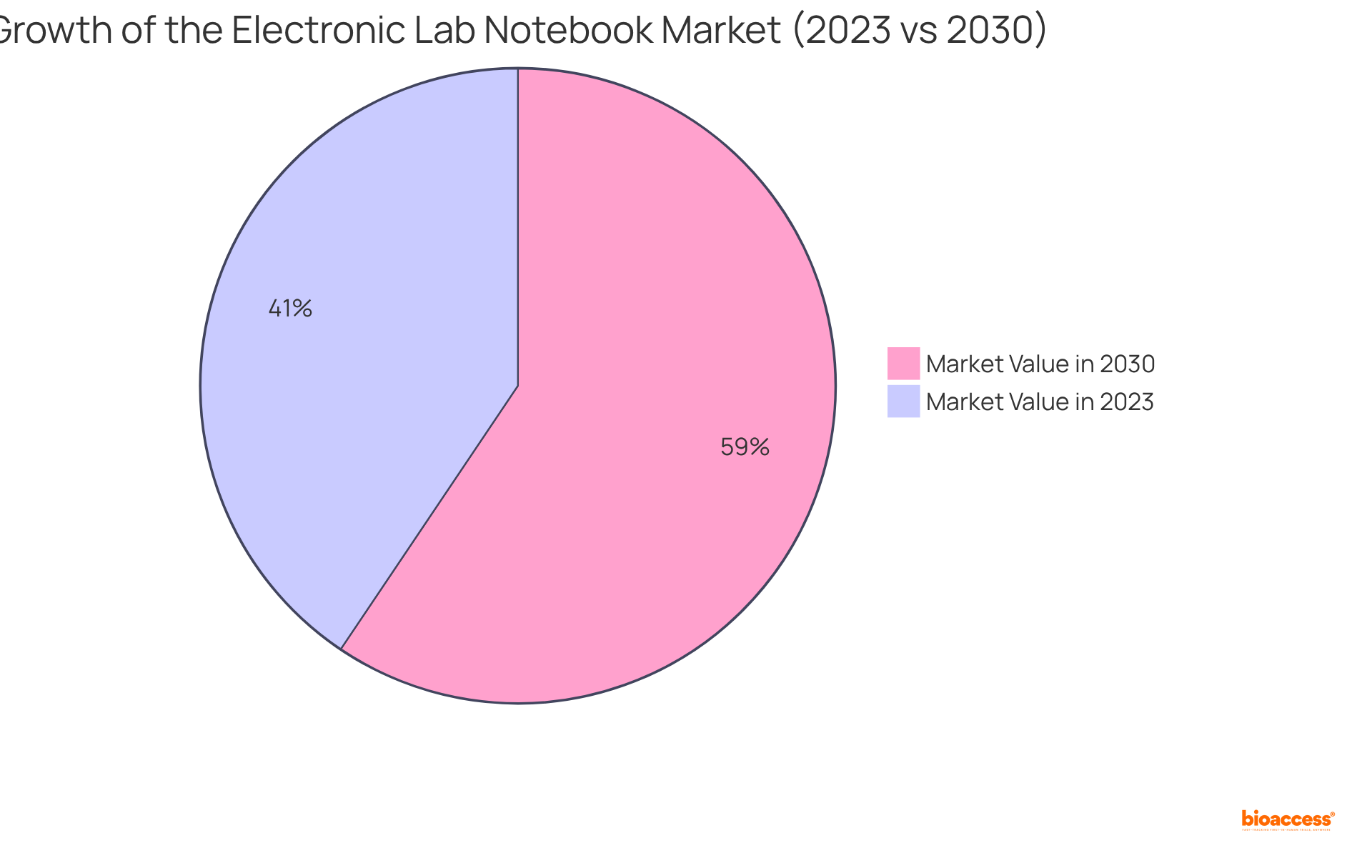
Electronic laboratory notebooks are equipped with advanced information security features that are essential for safeguarding sensitive research details. With robust encryption, stringent access controls, and comprehensive audit trails, these notebooks guarantee that only authorized personnel can access critical data. This level of security is vital for upholding regulations such as FDA 21 CFR Part 11, which governs electronic records and signatures.
Present adherence rates among investigative institutions suggest an increasing dependence on lab notebook electronic systems, as they assist in following these strict regulations. For instance, organizations using electronic laboratory notebooks have reported significantly enhanced compliance rates, with many attaining almost complete adherence to FDA standards.
By utilizing lab notebook electronic tools, scientists not only protect their intellectual property but also ensure that their information remains private and secure during the investigation process, ultimately improving the integrity of their results.
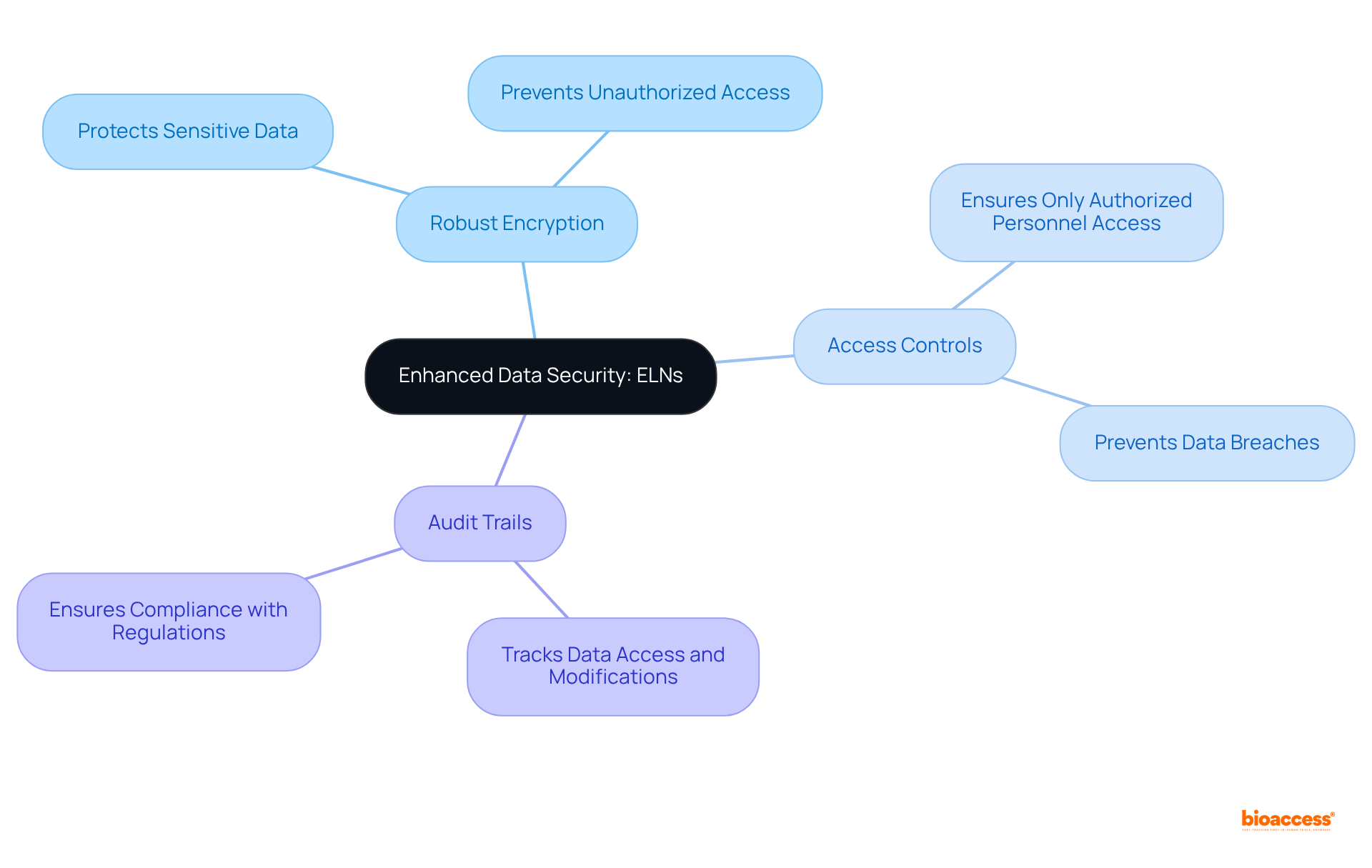
Lab notebook electronic are pivotal in enhancing collaboration among research teams by allowing multiple users to access and edit documents in real-time. This functionality is particularly advantageous for cross-functional teams engaged in complex projects, facilitating seamless sharing of information, protocols, and results. Researchers can easily comment on each other's work, track changes, and maintain a comprehensive record of contributions, fostering a culture of teamwork and innovation.
Studies indicate that implementing electronic lab notebooks can significantly reduce administrative overhead and accelerate experimentation by automating repetitive tasks and standardizing information entry. The staggering estimated annual loss across science and industry due to the failure to replicate or reproduce scientific results amounts to $20 billion, underscoring the critical need for effective documentation and collaboration to mitigate such losses. This cooperative environment is essential for expediting findings and enhancing overall project efficiency.
For instance, organizations like Newform Foods have reported increased productivity and improved knowledge sharing following the adoption of lab notebook electronic systems, which also enhance information security and privacy by allowing access limitations to authorized team members. Moreover, integrating lab notebook electronic systems with Laboratory Information Management Systems (LIMS) optimizes laboratory processes, while compliance with FDA 21 CFR Part 11 mandates features such as version control and audit trails, rendering lab notebook electronic tools indispensable for improving collaboration in clinical studies and ultimately leading to more effective and successful project outcomes.

A significant advantage of lab notebook electronic systems lies in their ability to enhance the organization of research information. ELNs empower researchers to categorize and tag their entries, which facilitates swift access to specific experiments or datasets. This systematic approach not only improves information retrieval but also significantly reduces the risk of loss or misplacement. By creating a well-structured digital repository, researchers can guarantee that their findings are easily accessible for analysis and reporting. This leads to more efficient investigation workflows, as evidenced by studies showing that clinical trials utilizing integrated information management solutions complete patient enrollment 30% faster.
Moreover, nearly 100 laboratories at the University of Wisconsin-Madison have adopted lab notebook electronic systems, underscoring improved collaboration and documentation. These results underscore the transformative impact of organized information management in research, particularly in addressing challenges such as information fragmentation and enhancing overall study efficiency.
To fully leverage the benefits of a lab notebook electronic system, researchers should consider implementing best practices for information organization and sharing, ensuring their management strategies align with the evolving landscape of clinical research.
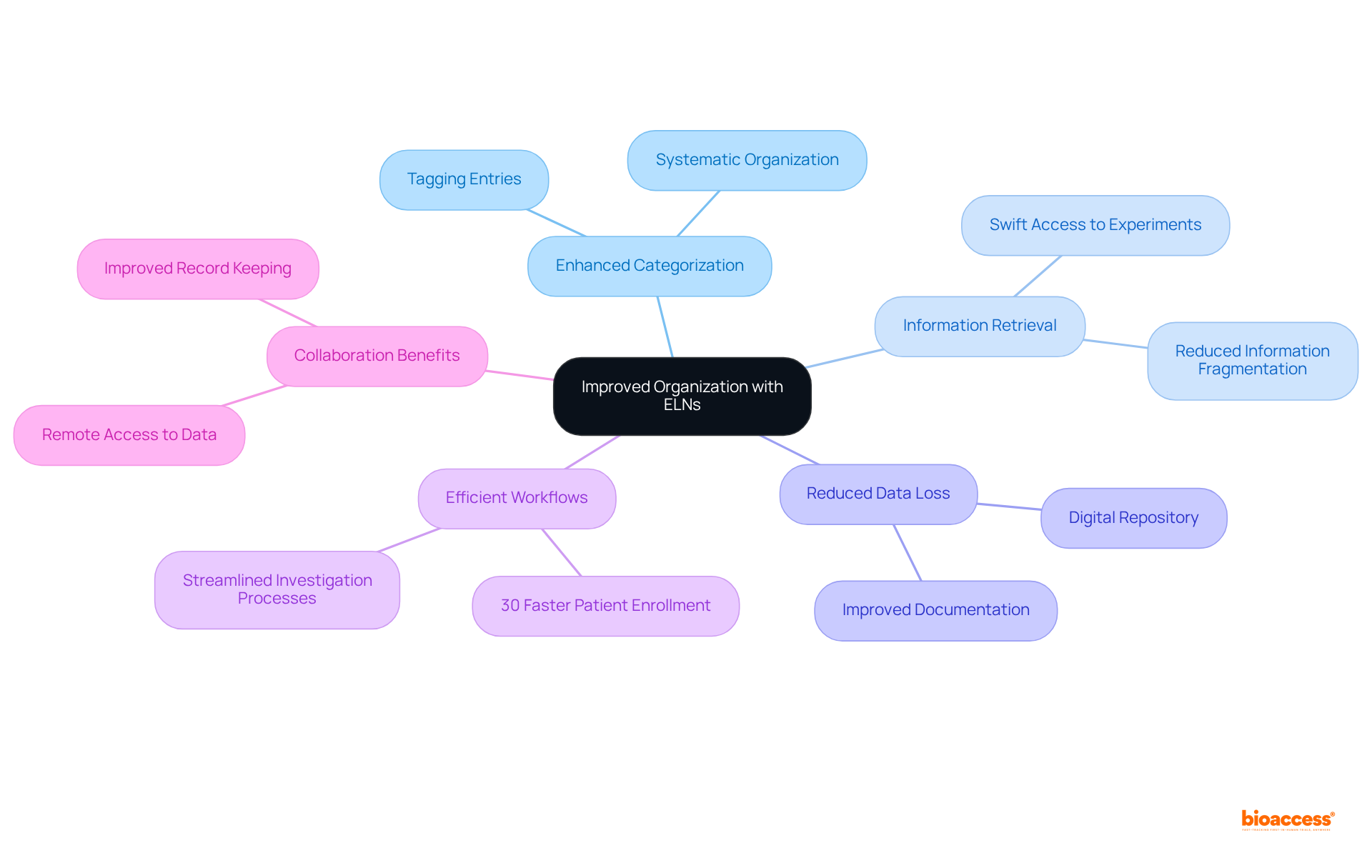
Lab notebook electronic tools significantly enhance time efficiency for researchers compared to conventional paper notebooks. By leveraging features such as automated data entry, intuitive search functions, and the ability to link experiments directly to raw data files, researchers can allocate more time to their scientific inquiries rather than administrative tasks.
Research indicates that implementing a lab notebook electronic can save scientists an average of 9 hours per week, thereby significantly boosting productivity and accelerating project timelines. Notably, 6 out of 7 users reported substantial time savings after transitioning to lab notebook electronic, with some researchers experiencing reductions of up to 17 hours weekly.
This efficiency is particularly crucial in the fast-paced Medtech and Biopharma industries, where the capacity to innovate rapidly can determine market success. Furthermore, lab notebook electronic systems enhance adherence to regulations through components such as audit trails and electronic signatures, ensuring security and reproducibility—elements that are vital in controlled settings.
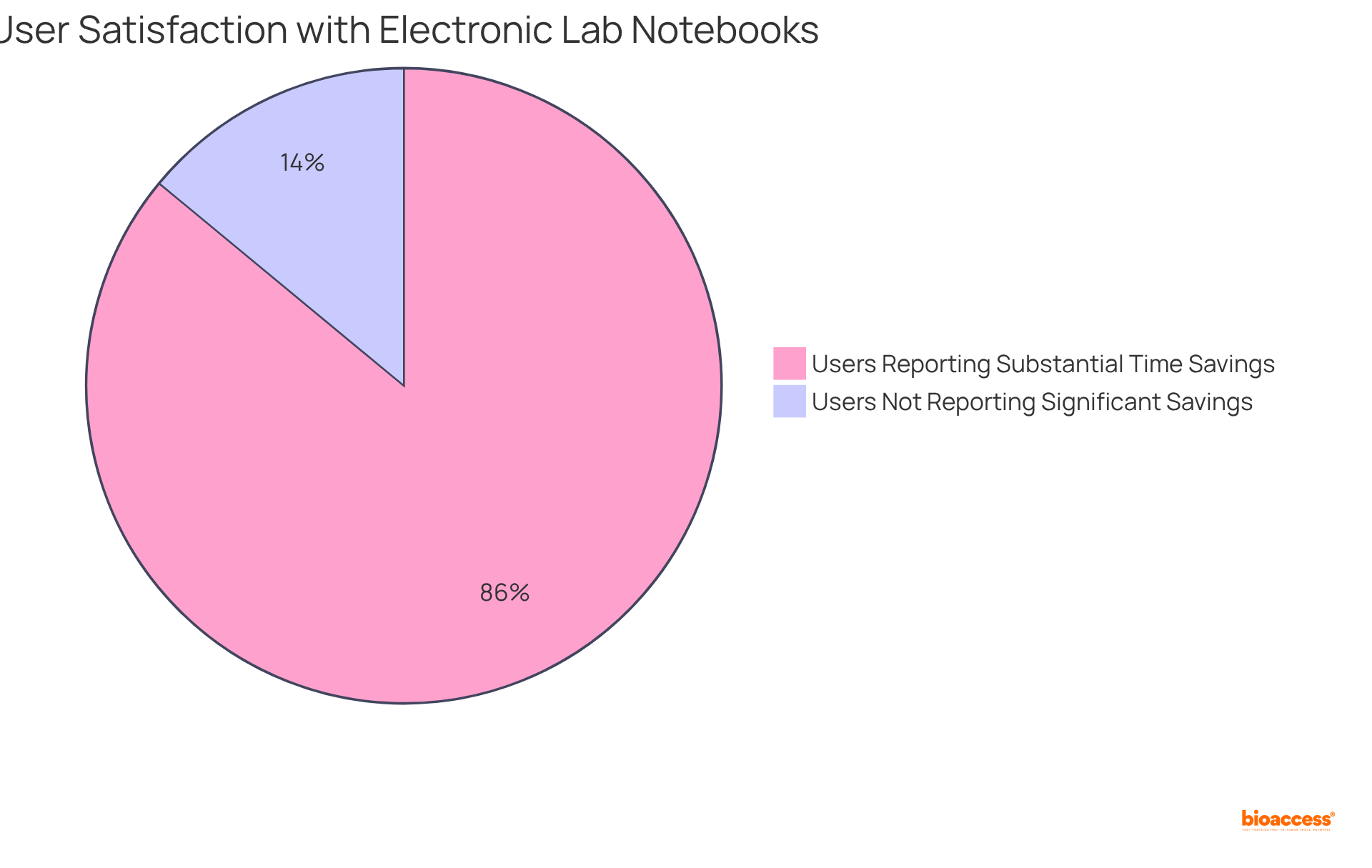
Lab notebook electronic systems stand out due to their robust integration capabilities with various research tools and software. This functionality allows researchers to link ELNs seamlessly with laboratory information management systems (LIMS), analysis software, and other digital platforms. By facilitating smooth information transfer between these systems, ELNs significantly reduce the need for manual data entry, thereby minimizing the potential for errors. Such integration not only streamlines workflows but also enhances the overall efficiency of research processes, enabling researchers to focus on their primary scientific objectives.
Current trends indicate a growing emphasis on LIMS integration, driven by the increasing complexities of information management and the demand for regulatory compliance. The global LIMS market is anticipated to grow from US$2.88 billion in 2025 to US$5.19 billion by 2030, reflecting a compound annual growth rate (CAGR) of 12.5%. For instance, the integration of electronic lab notebooks with LIMS guarantees that sample data entered in LIMS is readily accessible in the electronic lab notebook, fostering improved data traceability and expedited collaboration among researchers. This synergy is vital for promoting innovation and ensuring compliance in laboratory environments.
Illustrative examples of successful ELN and LIMS integrations underscore their potential. For instance, the combination of electronic laboratory notebooks with quality management systems (QMS) provides a structured framework for monitoring laboratory processes, ensuring compliance with regulatory standards, and proactively identifying quality issues. Such integrations lead to enhanced operational efficiency and increased customer satisfaction, demonstrating the transformative impact of lab notebook electronic systems in modern scientific environments. As Mikael Hagstroem, CEO of LabVantage Solutions, articulates, "In addition to empowering all lab members and increasing productivity, the updates fortify our platform's data management efficiency, which is a crucial basis for the upcoming generation of SaaS products with integrated AI agents.

Introducing lab notebook electronic systems can yield substantial cost reductions for scientific institutions by diminishing the need for physical storage, paper materials, and administrative expenses. This transition not only maximizes funding for studies but also enhances operational efficiency. For instance, researchers using electronic lab notebooks report saving an average of 9 hours weekly, with some users saving as much as 17 hours weekly. This time can be redirected towards crucial research activities rather than administrative tasks. In a funding environment where resources are often limited, the cost-efficiency of lab notebook electronic options becomes particularly appealing for Medtech and Biopharma innovators.
Furthermore, the financial advantages extend beyond mere direct savings. By optimizing project workflows and reducing the time required for documentation and reporting, lab notebook electronic systems enable researchers to complete projects more swiftly and efficiently. This acceleration can result in a faster time-to-market for new products, ultimately improving the return on investment (ROI) for research initiatives. For example, entities that have adopted lab notebook electronic systems have reported a potential ROI within 3 to 4 months, with the time spent on drafting reports decreasing from 3 hours weekly to just 3 hours monthly, highlighting significant efficiency gains.
Additionally, enrollment in clinical studies is 50% quicker than in conventional markets, further illustrating how electronic laboratory notebooks facilitate faster project completion. In summary, the integration of lab notebook electronic systems not only bolsters research budgets but also fosters a more productive research environment, establishing them as an essential resource for Medtech and Biopharma companies aiming to innovate effectively. As LaToya Lee Jones observes, "These returns will be attained through enhanced information precision, effective error detection and correction, faster laboratory processing, greater information searchability, reduced manual transcription, and eliminating experiment duplications.
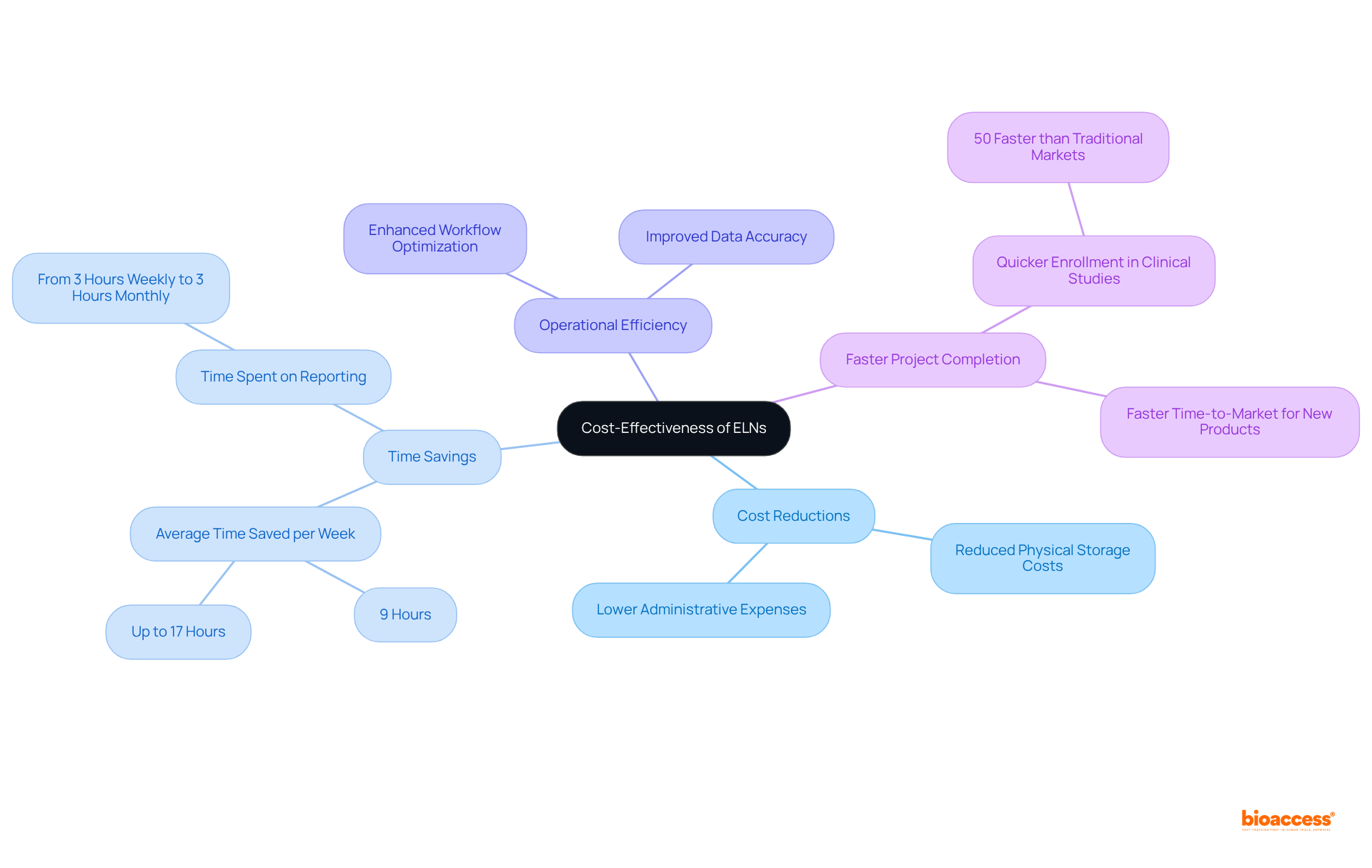
Electronic laboratory notebooks serve as essential instruments for researchers striving to meet stringent regulatory standards. With features such as electronic signatures, audit trails, and integrity checks, these notebooks guarantee that all documentation complies with industry regulations. For organizations operating in regulated environments, particularly within the Medtech and Biopharma sectors, adherence to regulations is vital for successful product development and market entry. By implementing lab notebook electronic systems, researchers can streamline their compliance efforts, significantly enhancing their information management practices to align with regulatory expectations.
For instance, Riverside Medical Group reported a remarkable 93% reduction in clinical documentation query time following the integration of predictive analytics, illustrating how effective data management can lead to improved regulatory outcomes. Likewise, Memorial Health System experienced a 78% decrease in false-positive adherence alerts and realized $4.2 million in annual savings through the adoption of regulatory analytics, further showcasing the benefits of combining advanced technologies like electronic lab notebooks with robust adherence strategies. Moreover, organizations utilizing regulatory analytics have observed a 63% reduction in compliance-related incidents, underscoring the importance of integrating advanced technologies such as lab notebook electronic systems into their workflows.
As the global lab notebook electronic market is projected to grow from USD 613.5 million in 2023 to USD 1,276.3 million by 2033, the adoption of these lab notebook electronic solutions is becoming increasingly crucial for ensuring compliance and enhancing operational efficiency in clinical studies. As Sharavanan emphasized, 'organizations must utilize their technology and best practices to improve efficiency and effectiveness,' highlighting the strategic importance of lab notebook electronic in the evolving landscape of clinical research.

One of the most significant advantages of lab notebook electronic systems is their unparalleled accessibility. Researchers can access their lab notebook electronic from any device with an internet connection, enabling seamless work from the lab, home, or while traveling. This flexibility is especially beneficial for collaborative projects involving team members across various locations. By enabling remote access to study data, electronic lab notebooks encourage ongoing advancement and dialogue, ensuring that investigative efforts stay on course despite physical distance.
Studies show that remote workers are 61% more likely to report increased productivity when equipped with effective digital tools, such as ELNs. Additionally, 74% of employees feel happier when working remotely, and 77% believe their productivity is higher in a home setting. This capability not only improves individual effectiveness but also promotes a cooperative atmosphere where teams can exchange insights and updates instantly, ultimately advancing project results. Furthermore, remote work can significantly reduce greenhouse gas emissions, with one day of remote work cutting emissions by 2%.
The effect of such accessibility on scholarly productivity is profound, as it enables timely decision-making and decreases delays often linked with conventional documentation methods. In essence, lab notebook electronic systems empower study groups to sustain momentum and reach their objectives, irrespective of their location, while also fostering a more sustainable work environment.
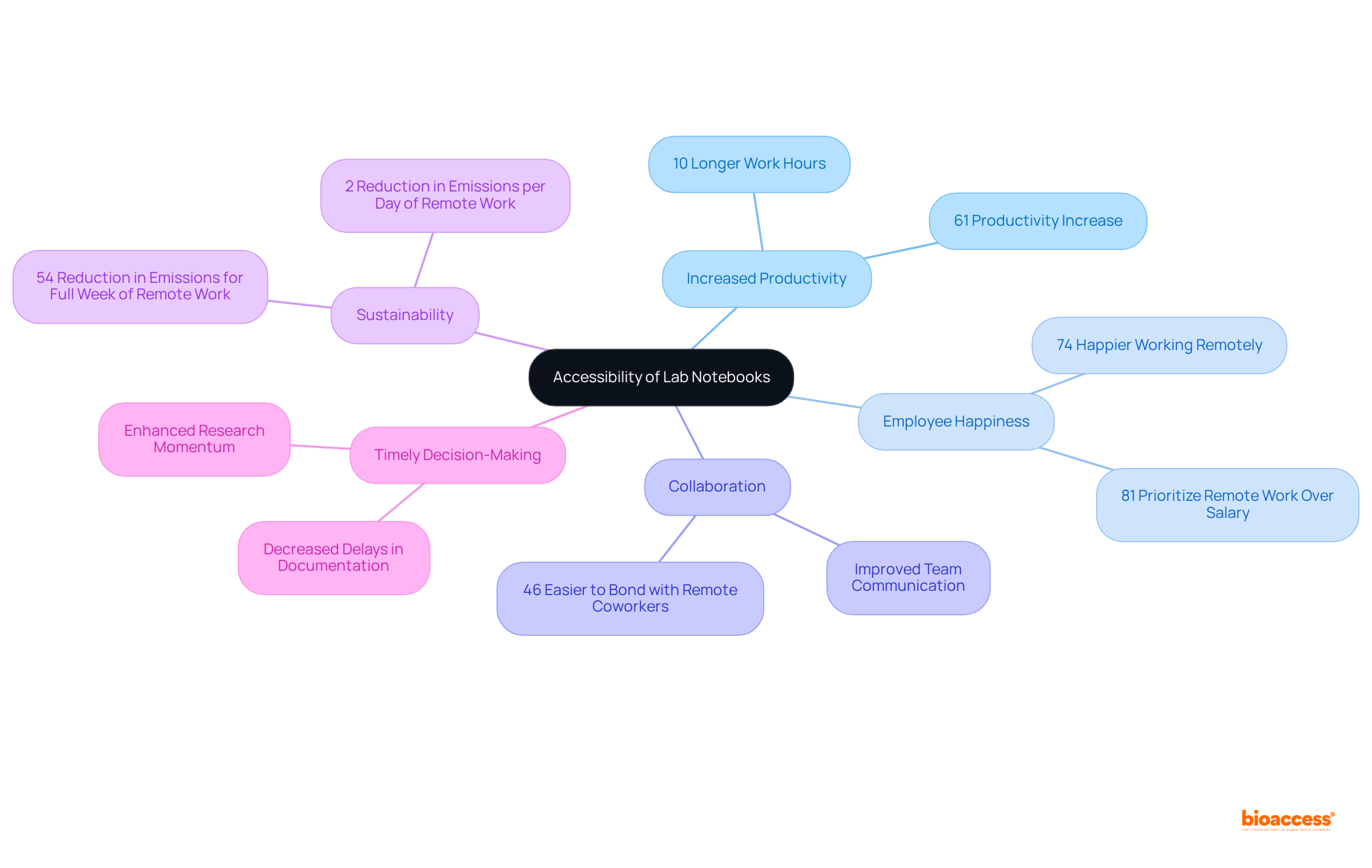
In the rapidly evolving landscape of scientific inquiry, digital laboratory notebooks are essential for organizations striving to maintain a competitive edge. By integrating advanced technologies such as artificial intelligence and machine learning, lab notebook electronic systems significantly enhance data management practices. This integration allows researchers to streamline workflows and improve accuracy, which is crucial in today's demanding environment.
As regulatory requirements become increasingly stringent, lab notebook electronic solutions offer a flexible approach that adapts to shifting compliance standards, ensuring that organizations can meet evolving demands without sacrificing quality. This adaptability is particularly vital for the Medtech, Biopharma, and Radiopharma sectors, where staying ahead of regulatory changes is essential for innovation and success.
Recent statistics reveal that 77% of companies are either utilizing or considering the integration of AI in their operations, underscoring the importance of incorporating such technologies alongside lab notebook electronic solutions. Mark Cuban emphasizes the necessity of understanding AI, stating, "Artificial Intelligence, deep learning, machine learning—whatever you’re doing if you don’t understand it—learn it. Because otherwise, you’re going to be a dinosaur within 3 years."
By adopting lab notebook electronic systems, organizations can not only future-proof their research practices but also position themselves to leverage technological advancements, ultimately driving progress in their fields. For example, a recent case study illustrated how a leading Biopharma company utilized lab notebook electronic systems to streamline compliance processes, resulting in a 30% reduction in time spent on regulatory documentation.
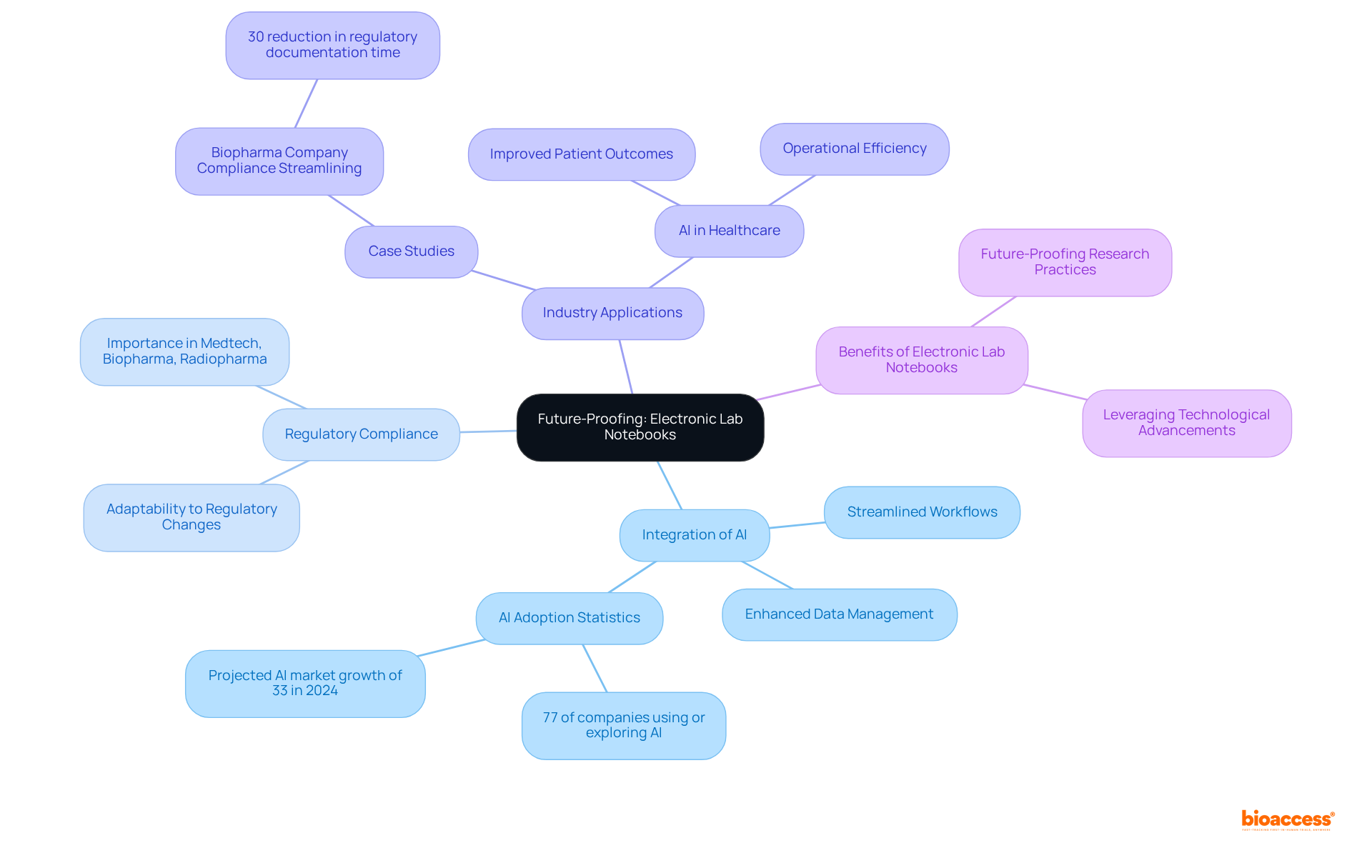
The advantages of using electronic lab notebooks (ELNs) in research are profound, offering a modern solution to the challenges faced by researchers today. By transitioning from traditional paper notebooks to digital systems, researchers can enhance productivity, ensure data security, and improve collaboration, all while adhering to stringent regulatory standards. This shift not only streamlines workflows but also fosters a culture of innovation, enabling scientists to focus on what truly matters—advancing their research.
Throughout the article, key benefits of ELNs have been highlighted, including:
The enhanced data security features of ELNs protect sensitive information, while their collaborative capabilities allow teams to work together more effectively, regardless of location. Furthermore, the cost-effectiveness of ELNs positions them as an essential asset for research institutions aiming to maximize their budgets and expedite project timelines.
In conclusion, adopting electronic lab notebooks represents a strategic move for researchers looking to stay ahead in a rapidly evolving scientific landscape. By leveraging the benefits of ELNs, organizations can not only enhance their operational efficiency but also future-proof their research practices against the challenges of tomorrow. Embracing these digital solutions is not merely an option; it is a necessity for those committed to driving innovation and achieving success in their fields.
What is bioaccess® and how does it relate to electronic lab notebooks?
bioaccess® integrates electronic lab notebook systems into study workflows to accelerate the clinical investigation process, enhancing information organization and retrieval, allowing researchers to focus on innovation instead of administrative tasks.
Why are electronic lab notebooks important in Medtech and Biopharma?
In the fast-paced realms of Medtech and Biopharma, electronic lab notebooks are crucial as they ensure scientific information is readily accessible and compliant with regulatory standards, leading to expedited ethical approvals and faster patient enrollment in clinical trials.
What is the market outlook for electronic lab notebooks?
The electronic lab notebook market was valued at USD 659.8 million in 2023 and is projected to reach USD 966.2 million by 2030, growing at a CAGR of 7.3% from 2025 to 2030.
How do electronic lab notebooks enhance data security?
Electronic lab notebooks provide advanced security features such as robust encryption, stringent access controls, and comprehensive audit trails, ensuring that only authorized personnel can access sensitive research data.
What regulations do electronic lab notebooks help comply with?
Electronic lab notebooks help organizations comply with regulations such as FDA 21 CFR Part 11, which governs electronic records and signatures, and many institutions using these notebooks report enhanced compliance rates.
How do electronic lab notebooks facilitate collaboration among research teams?
Electronic lab notebooks allow multiple users to access and edit documents in real-time, fostering seamless sharing of information, protocols, and results, which enhances collaboration and teamwork in research projects.
What are the benefits of using electronic lab notebooks in terms of productivity?
Implementing electronic lab notebooks can significantly reduce administrative overhead, automate repetitive tasks, and standardize information entry, ultimately accelerating experimentation and improving overall project efficiency.
What is the impact of poor documentation on scientific research?
The failure to replicate or reproduce scientific results leads to an estimated annual loss of $20 billion across science and industry, highlighting the critical need for effective documentation and collaboration.
How do electronic lab notebooks integrate with other systems?
Electronic lab notebooks can be integrated with Laboratory Information Management Systems (LIMS), optimizing laboratory processes and enhancing compliance with FDA regulations through features like version control and audit trails.